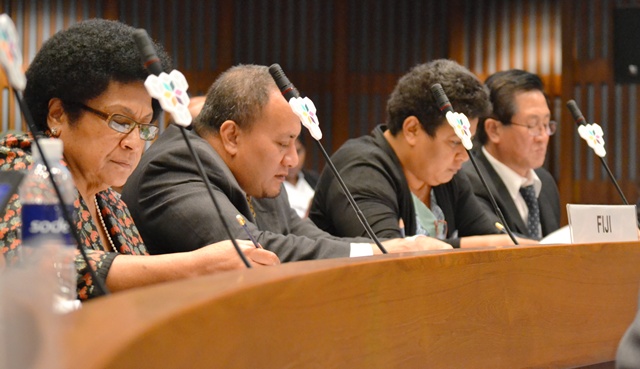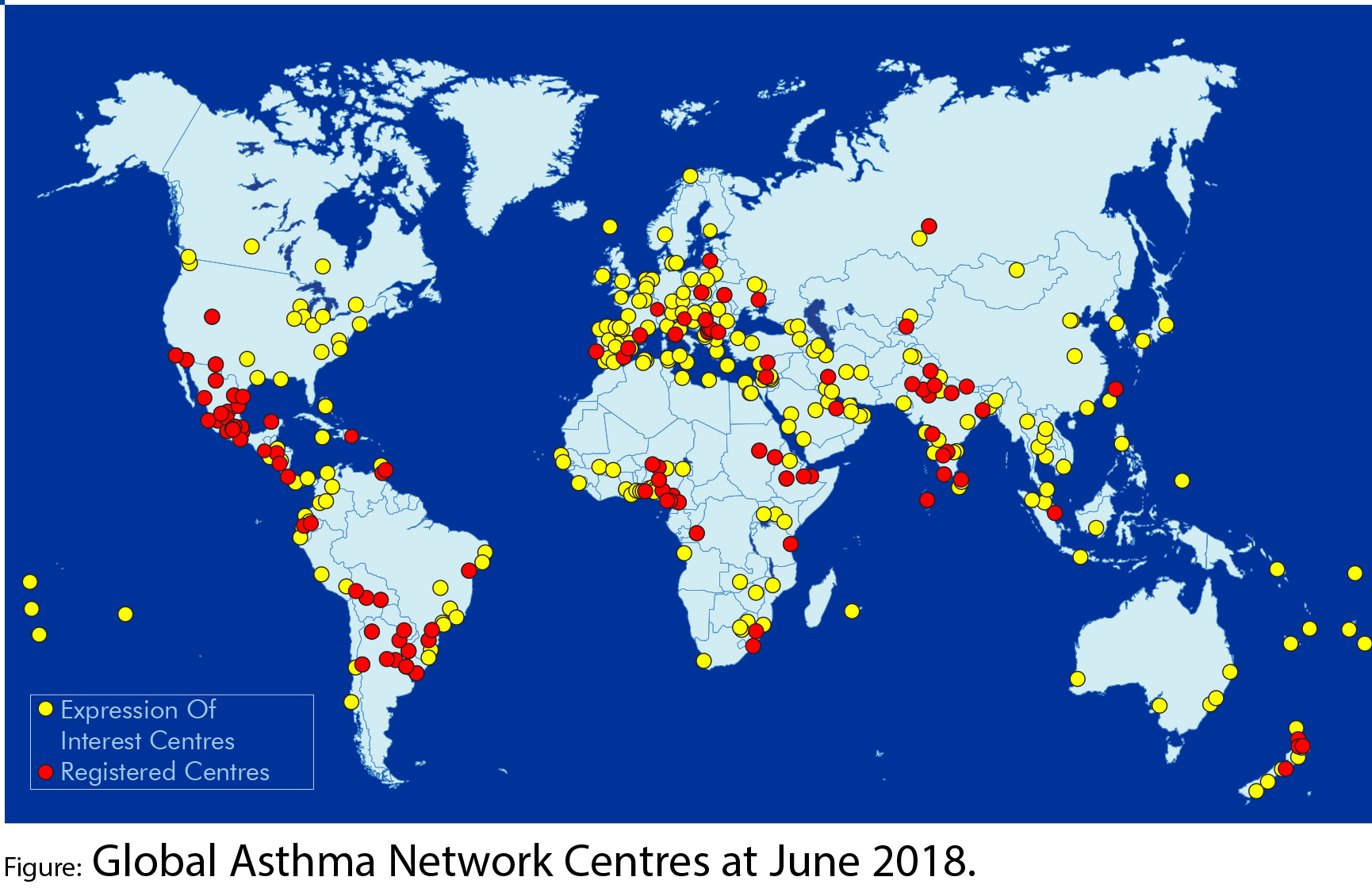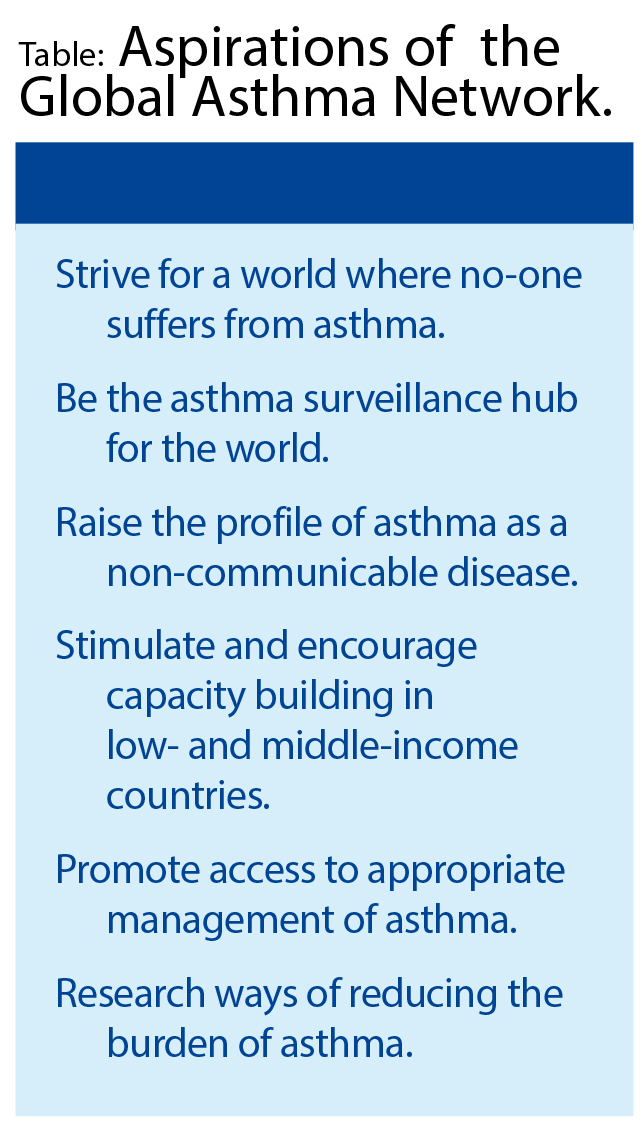
The Global Asthma Network
The Global Asthma Network (GAN) aims to reduce the global suffering from asthma by preventing asthma and improving asthma care with a focus on low- and middle-income countries (LMICs). GAN activities include surveillance of asthma, research, and capacity building; improving access to effective asthma management, particularly affordable quality-assured essential asthma medicines; and advocating for asthma to be high on the non-communicable disease (NCD) and public health agendas (Table). GAN builds on the work of the International Study of Asthma and Allergies in Childhood (ISAAC) and The International Union Against Tuberculosis and Lung Disease (The Union).
What does GAN do?
Established in 2012, GAN plays a crucial role in collecting standardised asthma data on adults and children globally. In this regard, GAN is filling an important gap. The last global asthma surveys were ISAAC in children (2002-3) and the World Health Survey in adults (2002-4). The present GAN survey began in 2017. By June 2018, there were 353 centres in 135 countries involved in some way in GAN, with 127 centres in 53 countries registered to undertake GAN Phase I (Figure) and identified on the GAN website (www. globalasthmanetwork.org). GAN is operating on the ISAAC principles of collaborative and systematic application of standardised methodologies suitable for use in all settings in the world, and has added to the ISAAC approach by studying asthma in adults as well as children. A 10-member international Steering Group (the authors of this chapter) leads GAN and is responsible for developing and overseeing the GAN work programme, including GAN advocacy activities. The GAN Global Centre is located in Auckland, New Zealand. It takes a lead in co-ordinating global surveys, conducting methodology checks, overseeing publications, and maintaining the GAN website. GAN also published the Global Asthma Report 2014, distributed to 2500 recipients, with approximately 75,000 downloads of the report from the website.
Partnerships
Partnerships for global asthma work are important for GAN. It has established communication with worldwide organisations concerned with respiratory health and NCDs. The WHO acknowledged GAN’s work with the 2017 appointment of the Chair of GAN (Innes Asher) to the inaugural WHO Expert Panel on NCDs as a Chronic Respiratory Diseases expert. GAN is a member of the Global Alliance against Chronic Respiratory Diseases (GARD). In 2017, GAN was one of several partners in two successful grants, involving 18 organisations in 11 countries directed by the Liverpool School of Tropical Medicine (Bertie Squire and Kevin Mortimer), aiming to improve lung health (including asthma) and tuberculosis (TB) outcomes in Africa.
GAN Phase I
GAN Phase I (Asthma Global Surveillance: Prevalence, Severity, Management and Risk Factors) is underway. The GAN Phase I Co-ordinator is Neil Pearce, who also leads the Phase I Data Centre in London (United Kingdom); Luis García-Marcos leads the Phase I Data Centre, in Murcia (Spain). GAN Phase I will assess time trends in asthma prevalence, severity and risk factors in centres that participated in ISAAC Phase Three and will include new centres. Participant recruitment is in schools, with schools selected at random within a specified geographical area. Two age groups of school children are involved (13-14 year olds [compulsory age group] and 6-7 year olds [optional age group]), as well as parents/caregivers of each age group [optional group]. Participants complete written questionnaires, developed from the ISAAC Phase Three questionnaire with additional questions on asthma management and the environment. For the adolescents, a non-spoken video questionnaire is available for optional use. A sample size of 3000 per age group per centre is sought to give sufficient power to detect differences in the severity of asthma. Tools enabling centres to follow and use the methodology are available on the GAN website.
Conclusion
GAN Phase I is the only global population-based study of asthma conducted since 2003 (ISAAC Phase Three) and will contribute new information on adults and children. GAN will build on the ISAAC findings by collecting new information on asthma prevalence, severity, diagnoses, emergency room visits, hospital admissions, management, and use of essential asthma medicines. GAN aims to provide further evidence to improve recognition of asthma as an important NCD and to understand how to reduce global asthma burden.


